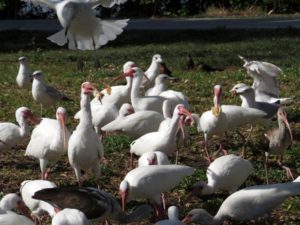
Corresponding Author: Daniel Becker, daniel.becker3@montana.edu
Urban parks, backyards, landfills, and agricultural fields provide wildlife with access to novel food sources. Food provided by humans in these locations can dramatically alter patterns of animal site fidelity and movement between habitats, with consequences for pathogen spread across the landscape. To better understand how the extent of food-subsidized habitat affects wildlife distributions and infection patterns, researchers at the University of Georgia developed a mathematical model that assumes that animal dispersal and the duration of site occupancy will depend on food availability and abundance at a given site as well as animal infection status.
The authors found that both wildlife distributions across the landscape, and pathogen infection prevalence, depend on how productive food-provisioned patches are relative to natural patches. If habitats with human-provided food are occupied for longer by animals and produce more dispersers (such as might occur if animals survive better and produce more offspring when food is abundant and reliable), then infection becomes more widespread as more of the landscape is provisioned. However, if habitats with human-provided food produce fewer dispersers (such as might occur if animals stop moving as much when abundant food is present), then infection prevalence declines as more sites become provisioned. Reducing opportunities for pathogen spread can in turn increase landscape-level occupancy by wildlife.
These results highlight that when wildlife are fed by humans, whether at landfills or through recreational wildlife feeding, this can alter the spread of pathogens across a landscape. To determine if food provisioning is beneficial or detrimental for wildlife abundance and health, future work is needed to examine how births, deaths, and movement behavior respond to human-provided resources. These results are especially applicable to highly mobile, nomadic, urban-feeding species such as flying foxes, white ibis (pictured), and many other birds and mammals.
The research was led by Daniel Becker, a recent PhD graduate from the University of Georgia, overseen by University of Georgia faculty Sonia Altizer and Richard Hall, and resulted from a summer undergraduate research project from recent UC Berkeley undergraduate Celine Snedden.
Daniel J. Becker, Celine E. Snedden, Sonia Altizer, and Richard J. Hall, “Host Dispersal Responses to Resource Supplementation Determine Pathogen Spread in Wildlife Metapopulations,” The American Naturalist. https://doi.org/10.1086/699477. Online August 15 2018.
This summary article, photograph, and caption originally appeared as “Easy meals alter animal movement and disease spread” via the American Society of Naturalists. It is cross-posted here with permission from the author.